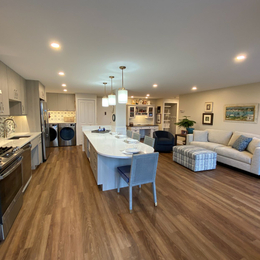
No Compromises
Thanks to a thoughtful renovation, an older homeowner with unique needs adapts to a new living space in her Center City high rise.
In order for a living space to truly feel like home, form and function must work together. Put another way, a home must not only look like a work of art but also accommodate a homeowner’s lifestyle. Ellen Farber says functionality becomes especially important as we age.
Farber owns Ellen Farber Strategic Design, an interior design firm based in Rittenhouse Square. She specializes in helping older clients live safely and independently, whether they choose to age in place or transition to a new living space.
Farber cites a recent renovation in which she reimagined the new home of an older client, Diana, with rather precise needs. Diana was born blind. Now in her 60s, she uses a wheelchair due to an accident in which she lost one of her legs.
As Diana prepared to move into a new unit in a Center City high rise (unnamed for matters of privacy), she knew the space would need significant and unique renovations. Enter Farber and her specialized expertise. In reviewing the space, Farber opted to take down several walls and widen hallways for easier navigation. She also determined she would have to add several amenities to facilitate Diana’s lifestyle: lower-height appliances with Braille controls; a completely redone bathroom, to include components such as a tile bench for easing into the shower, a comfort-height toilet, and a seamless threshold; pocket doors for ease of use; sensory details such as textured wallpaper and bright recessed lighting; and high-durability Acrovyn wainscoting for wall protection.
Farber, who raised her family in Lower Merion Township, has earned designations as a Certified Aging-in-Place Specialist, a Certified Living in Place Professional, and a Senior Home Safety Specialist, as well as a LEED Green Associate in sustainable design. In every project she undertakes, she strives to combine the principles of universal design, feng shui, and sustainability to create interiors she describes as “functional, well balanced, and cost effective.”
Diana may have more specialized needs than many people her age, but home renovations catering to the needs of older adults are likely to become big business in the years ahead. Adults ages 65 and older are projected to outnumber children under age 18 for the first time in U.S. history by 2034, according to projections from the U.S. Census Bureau.
Farber places fall prevention at the center of her efforts to renovate the home of a client who wishes to age in place, though she says not enough seniors take proactive steps to “fall proof” a home. Anticipated changes in a person’s hearing, vision, balance, and mobility must be taken into consideration.
“Outside of the home, you have to consider issues like lighting, railings, and walkways,” she says. “Inside, again, you have to look at lighting, plus secure flooring, the width of entryways, and, if there’s a wheelchair involved, the height of electric controls.”
Other “low-hanging fruit,” as Farber describes it: updating faucets to lever-style handles, choosing front-loading appliances, and eliminating clutter that might contribute to a fall.
“In the kitchen, it’s about accessibility, reachability, and storage,” she adds. “In the bathroom, it’s about reducing the slip factor of tile, utilizing grab bars, and updating to comfort-height toilets, meaning higher, not lower. It’s also a good idea to have a seat inside or outside the shower in case you’re feeling faint.”
Farber says every project begins with a client consultation in which she will “listen to how they live, and then figure out how to get it done.” In Diana’s case, the renovation began in July 2020 and concluded approximately one year later. Farber is thrilled with the results: a bright, attractive, easy-to-navigate space built around safety and comfort. More importantly, based on an enthusiastic note Farber received from her client in November 2020, Diana seems quite happy with the finished product.
“It just shows that you can make your home your way, and it can also be pretty, without costing a million dollars,” Farber says. “You want to feel good in your space. Even though she can’t see it, Diana senses the light, the space, the color, because she was with us every step of the way.”
Photograph courtesy of Ellen Farber Strategic Design
Published (and copyrighted) in Suburban Life magazine, January 2022.


